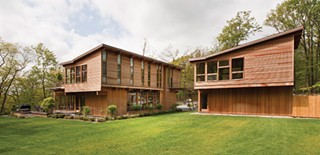Architect Ulises Liceaga paid $200,000 for eight pitched, rocky acres near the Cargill Reservoir in Cold Spring in 1999, three years before the Mexico City native married his New Yorker wife, Christina, with whom he today has five young children.
"In Mexico, if you can afford it, that's just what you do," says Christina, a former financial analyst who met her future husband when she was an exchange student in Mexico. "You buy a piece of land, and when you can, you build a family house, and then you keep it forever," she says.
For the next seven years, Ulises focused primarily on his career as a designer at the world famous firms of Cesar Pelli and Robert A. M. Stern and started a family. As time and money allowed, he began to prepare the Cold Spring property, clearing trees and blasting out a level space upon which to build a country getaway on a hill above a dead end road. The Hudson Highlands rubble was hauled away in truckloads to a nearby concrete maker, grateful for the donation.
In 2008, the rapidly expanding family, which lives during the week in a stunning Gramercy townhouse purchased by Christina's financier father in 1968 for $100,000, decided to build a prefabricated modern home they had found in Dwell magazine. Unfortunately, the kit-house maker contracted by the Liceagas went bust one-third of the way through the project. They'd paid in full, and lost most of their money. For seasoned real estate investors, it was a surprising setback. The Liceagas recovered what they could in construction materials from the bankrupt enterprise—a hodgepodge of roof, wall, and lumber pieces.
"It was sort of devastating, but I'm pretty laid-back," says Christina, semi-famous in the annals of modern Manhattan maternity for delivering her third child by herself, in the back of an SUV at 58th Street, with Ulises at the wheel, en route to the hospital. "I said, well, I have some shares I can sell. We found a builder up for the challenge, and Ulises had free rein."
And that's how the a plan for a semi-bargain modern morphed into a salvage-enriched-by-swank-design odyssey for the charismatic young father. Rolling the economic dice on the rebound, the budget and the artistic bravado backing the Liceagas' weekend retreat buoyed upward. It was an aggressive counter-cyclical market move. But embracing challenge comes naturally to Ulises. An avid kite surfer and yogi, he's also an accomplished equestrian whose commercial building designs win international competitions.
Connected but Apart
Flash forward to 2010. Now there's a 6,000-square-foot avant-garde family compound with firmly defined public and private spaces, oversized windows, and multiple terraces. The wide-open kitchen/dining/living area parallels an indoor pool with a woodland view. Equally striking is the "meditation room," a glassine zen retreat above the garage connected to the main house via a stylized suspension-bridge walkway. The upstairs features three bedrooms and three baths. Stainless steel toilets and sinks echo extensive cable railings securing a loft corridor. In the basement, there's a toy-strewn children's playroom, plus utility and storage areas and a galley office. The material clutter of modern childhood, and most of the home's bright dabs of color, are confined to the private areas, whereas earth tones and subdued metallics characterize the public realm.
"We don't need lots of family photographs scattered around the communal spaces, because we have all these little people running around," says Christina, whose year-old twin daughters have just begun to walk.
The exterior cedar panels alternate vertical with horizontal, heightening the rectilinear pattern language of the Liceaga house. In fact, the boutique design-and-build firm Ulises founded in New York is called Fractal Construction. A fractal is a geometric shape that, when divided, breaks into parts approximating a smaller copy of the whole, a property called self-similarity. Fractals form the mathematics defining natural structures such as snowflakes and enzymes, the orderly code that permeates a superficially chaotic universe.
"I was thinking about the play of lines, inside and out, but I was also inspired by the house-studio of Frida Kahlo and Diego Rivera, connected but also apart," says Ulises.
Considered the tap root of functionalist architecture in North America, the Kahlo/Rivera house, a major Mexico City cultural landmark built in 1930, consists of two concrete blocks joined by a rooftop bridge. The married artists, who had a turbulent but enduring relationship, wanted low-cost professional-cum-personal spaces, enabling both togetherness and privacy. Radical at the time, this sort of materials and land economy, driven by pragmatic design, has obviously prevailed in contemporary residential architecture ever since.
If the Kahlo/Rivera house is essentially a domestic art factory for tempestuous lovers, then the Liceaga's Cold Spring estate is a bindery for a family with five children under age eight and sophisticated tastemaker parents.
"A House Full of Tchotchkes Is My Worst Nightmare"
"Grandma's house full of tchotchkes is my worst nightmare," says Christina, a freckled natural beauty who pads around her dual-footprint showcase abode in cutoff sweatpants, flip-flops, and a ponytail.
Pulling back a wall of folding doors to reveal the serene 40' by 12' pool surrounded by floor-to-ceiling windows, the busy mother admits she rarely uses it.
"Ulises and the kids are in it constantly—we keep it at 90 degrees, and it has an ozone filtration system; there's no chlorine," says Christina, adding that it looks especially appealing when there's "two feet of snow outside."
Downstairs, the flooring is primarily porcelain tile. Upstairs, and in the meditation room, the Liceagas used Brazilian redwood. The decorative downstairs fishnet and crystal light installations are by Ingo Maurer, a renowned German industrial designer. The extraordinary kitchen ensemble, made by Alessi in partnership with Valcucine, was a $60,000 showroom sample. The furniture is mostly refinished family heirlooms. Ulisses obtained an estimate for geothermal, but the $150,000 tab proved too pricey. The house is wired for photovoltaic, which the couple intends to install later. Right now, however, they're embracing being fully present and enjoying Hudson Valley weekends.
"We're so busy during the week, this house is where we really learn to cohabit," says Christina. "The three older kids can basically do whatever they want outdoors, they can't get hit by a car here."
















